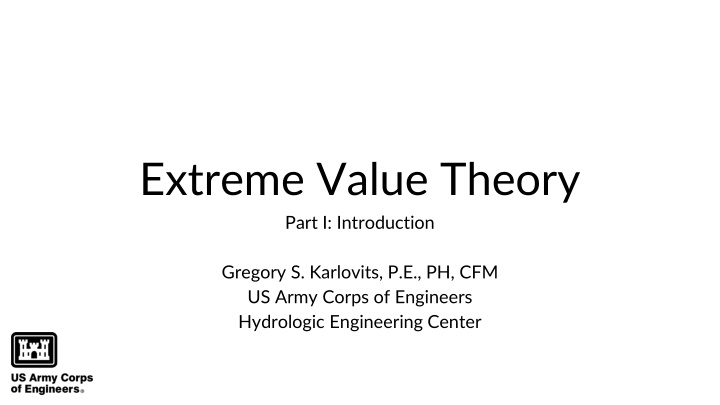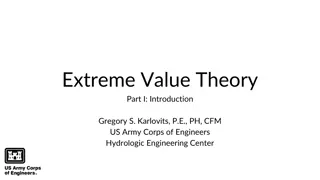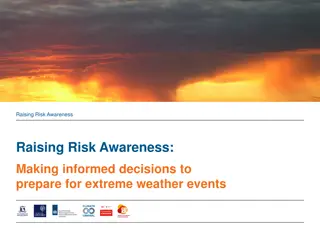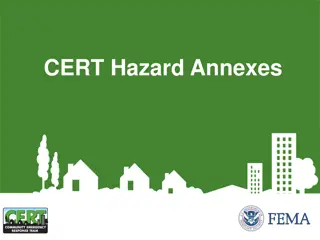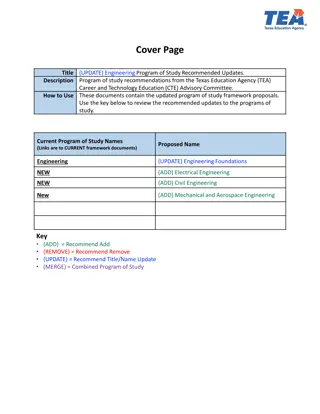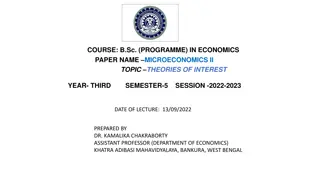Extreme Value Theory in Civil Engineering
Introduction to Extreme Value Theory (EVT) in civil engineering focusing on the analysis of extremes such as shear strength, slope stability, and load factors. The theory, exemplified by Emil Julius Gumbel, questions the likelihood of individual observations falling outside expected distributions. EVT models behaviors of extremes to inform decision-making in managing hydrologic events like floods and droughts. Lectures cover order statistics, extreme value theorems, and the application of EVT models in engineering practices.
Download Presentation

Please find below an Image/Link to download the presentation.
The content on the website is provided AS IS for your information and personal use only. It may not be sold, licensed, or shared on other websites without obtaining consent from the author.If you encounter any issues during the download, it is possible that the publisher has removed the file from their server.
You are allowed to download the files provided on this website for personal or commercial use, subject to the condition that they are used lawfully. All files are the property of their respective owners.
The content on the website is provided AS IS for your information and personal use only. It may not be sold, licensed, or shared on other websites without obtaining consent from the author.
E N D
Presentation Transcript
Extreme Value Theory Part I: Introduction Gregory S. Karlovits, P.E., PH, CFM US Army Corps of Engineers Hydrologic Engineering Center
Extreme Value Theory Civil engineering is largely a practice of extremes minimum shear strength and maximum shear stress for slope stability safety factor minimum resistance and maximum load for LRFD minimum time to collision and maximum traffic load minimum and maximum annual flows on a river 2
Emil Julius Gumbel It s impossible that the improbable will never happen. 3
Gumbels EV Questions Does an individual observation in a sample taken from a distribution, alleged to be known, fall outside what may reasonably be expected? Does a series of extreme values exhibit a regular behavior? 4
Extreme Value Theory We seek models for the behaviors of extremes Models are applied for making decisions Floods and droughts (hydrologic extremes) drive investment 5
Lecture Outline 1. Order Statistics 2. First Extreme Value Theorem 3. Second Extreme Value Theorem 6
Extreme Value Theory Part II: Order Statistics and More Gregory S. Karlovits, P.E., PH, CFM US Army Corps of Engineers Hydrologic Engineering Center
Order Statistics Sample minimum ?1 8 Sample n = 10 24 Sample maximum ?? Sorted Order Statistics X1 X2 X3 X4 X5 X6 X7 X8 X9 X10 19 20 8 15 9 22 24 16 14 12 24 22 20 19 16 15 14 12 9 8 X(10) X(9) X(8) X(7) X(6) X(5) X(4) X(3) X(2) X(1) Sample range ?? ?1 16 Sample median n odd 15.5 ? ?+1 is an order statistic 2 n even ? ? + ? ?+1 is not an order statistic 2 2 2 8
Rank Plot We can show the cumulative distribution for the sample based on the ranks, but how well do we think it reflects the population? Do you think that another sample from this population will never exceed 24? 9
Order Statistics of the Uniform Distribution The exceedance probabilities of a random sample of values from any population have a uniform distribution bounded on the interval (0, 1). U(0, 1) Why is this useful? We often are interested in an empirical estimate for the exceedance probabilities for values in a sample. 10
Order Statistics of the Uniform Distribution Proof: CDF 1,000 samples from a standard normal distribution Histogram of cumulative probabilities 11
Order Statistics of the Uniform Distribution Why care? The same order statistic in repeated samples from the same population will not always have the same exceedance probability. Let s examine the distribution of F(x(n)). Generate a sample from the standard normal distribution of size 100 Find the cumulative probability for sample maximum x(100) (= x(n)) using CDF Repeat a large number of times Plot the empirical density 12
Order Statistics of the Uniform Distribution What does this show? The sample maximum has an uncertain exceedance probability. In fact, the exceedance probability has a probability distribution, the beta distribution, with parameters computed from the rank and the sample size. Median Mean Beta(100, 1) Density ? ?? ~???? ?,? + 1 ? 13
Order Statistics of the Uniform Distribution What is the consequence? We just derived two very important plotting position estimators: F(x(n)), n = 100, 100,000 samples Property Sample Exact Median 0.9931 0.9932 The median plotting position ? ? ?,? =? 0.3175 approx for median of beta dist Mean 0.9901 0.9901 ? + 0.365 The Weibull (mean) plotting position ? ? ? ?,? = exact mean of beta dist ? + 1 14
Order Statistics of the Uniform Distribution asymmetrical and wide Other consequences? We can compute confidence limits for empirical exceedance probability and show just how uncertain it is. x(100) x(99) 90% CI Difference in plotting position choice matters most at tails Uncertainty in empirical frequency large at tails symmetrical uncertainty x(2) x(1) 15
Relation to Extreme Value Theory This procedure explores the uncertainty in exceedance probability for a sample We can model this with the beta distribution What if I want to get the distribution of the values for a particular order statistic? Depends on i, n, and also f(x) Straightforward for x(1) and x(n) 16
Summary Order statistics look at data based on their rank The true exceedance probability for an order statistic is uncertain Plotting position uncertainty can be modeled with the beta distribution 17
Extreme Value Theory Part III: First Extreme Value Theorem Gregory S. Karlovits, P.E., PH, CFM US Army Corps of Engineers Hydrologic Engineering Center
How do the extremes vary? Usually we are most interested in f(x(n)) Repeated samples, n = 10 from a population: Sample Number 6 26 26 24 94 62 46 74 99 6 67 84 81 79 7 15 71 33 43 44 35 84 99 1 48 92 4 76 63 35 27 87 12 80 92 2 25 48 26 13 50 81 92 96 77 85 96 3 40 44 6 88 92 14 63 66 37 13 92 4 74 80 17 47 33 62 82 21 10 32 82 5 7 76 79 23 56 44 9 72 61 45 31 79 8 64 32 68 2 87 86 72 37 57 65 87 9 74 13 44 88 91 26 98 99 15 15 99 10 80 48 9 29 8 35 4 74 96 31 96 11 95 90 24 15 26 87 33 61 66 47 95 12 76 31 70 93 8 94 72 65 5 39 94 1 2 3 4 5 6 7 8 9 10 Max Sample Value distribution of these 19
Block Maxima Non-overlapping groups Equal size sample 1 sample 2 sample 3 sample 4 sample 5 sample 6 20
Modelling Extremes Some assumptions: All of the values come from the same population, with possibly unknown density function f(x; ) f(x; ) would be the distribution for every day of flow All of the values are taken independently Using block maxima with big enough blocks helps ensure this Motivation for the water year We can estimate a model for f(x(n)) 21
Fisher-Tippett-Gnedenko Theorem The distribution of the maximum of repeated samples of a homogeneous population converge to one of three probability distributions: EV1: Gumbel Distribution EV2: Fr chet Distribution EV3: Weibull Distribution All three distributions can be represented with a single distribution: Generalized Extreme Value Distribution 22
Namesake Emil J. Gumbel Maurice R. Fr chet Waloddi Weibull 23
Central Limit Theorem Think of this as the central limit theorem (CLT) except for maxima: CLT states that the sample average of repeated draws of size n from a population converges to a normal distribution ? ??=?1+ + ?? 1?? ?? ?? ? First EV Theorem states that the maximum of repeated draws of size n from a population converges to a GEV distribution 24
GEV Distribution ? ?; , , = ? ? ? 1??? 1 ? 0 ? = ? = 0 25
Convergence EV convergence depends on three things: The distribution of the parent population f(x; ) Changes to which EV distribution samples converge The number of events per block n The number of blocks forming the estimate How good is the estimate of the GEV parameters? lim ? ? ?? = GEV Distribution 26
Convergence: Maximum Domain of Attraction EV1: Gumbel (GEV = 0) f(x; ) in the exponential family EV2: Fr chet Distribution (GEV < 0) f(x; ) is heavy-tailed EV3: Weibull Distribution (GEV > 0) f(x; ) is light-tailed or upper-bounded 27
Convergence of Block Maxima Block size (maximum of this many ) 28
Convergence: Why isn t this AMS GEV? Three primary factors delaying convergence: Too few independent events per block Too few blocks (years) creating AMS Inhomogeneous parent population Parent population of events lim ? ? ?? = GEV Distribution Green: Light tails Red: Heavy tails Blue: Exponential When n is small, ? ?? ~ Kappa Distribution Line of convergence to GEV 29
Convergence Annual Maximum Streamflow Although we take the maximum of 365 days of flows, what we care about most are floods Few real floods happen each year at most sites Some years don t have any events we would consider floods Streamflow records are mixed and serially correlated Effectively we are taking the maxima of far fewer than 365 events Bottom line: Bulletin 17 procedures do not generally meet the assumptions required of EVT analysis 30
31 Inland Flood Hazards: Human, Riparian, and Aquatic Communities (Wohl, 2011)
Convergence Precipitation Conversely, it is much easier to isolate independent rainfall events of the same causal mechanism Example: easy to identify which rainfall events in Florida are caused by tropical storms Eliminates mixtures Some types of storms occur several times per year at some locations Rainfall is much easier to analyze in traditional EVT manner Plus, regionalization is much easier than for streamflow 32
Summary The first extreme value theorem provides a model for the magnitude of block maxima Annual maximum series tend to converge to the generalized extreme value distribution Several issues can prevent sample convergence to GEV 33
Extreme Value Theory Part IV: Second Extreme Value Theorem Gregory S. Karlovits, P.E., PH, CFM US Army Corps of Engineers Hydrologic Engineering Center
Peaks Over Threshold Block Maxima Block maximum approach throws out data Some blocks have small maxima Smaller than non-maxima in other blocks What if we consider independent local maxima? Local Maxima Threshold 35
Peaks Over Threshold Zero or more local maxima per block Count of peaks needs to be considered Need to ensure local maxima sufficiently independent No longer dealing with order statistics Cumulative probability 1 AEP 36
Peaks Over Threshold We are interested in the distribution of excesses: Given a set of values that exceed a threshold, What is the distribution of the excess? The collection of peaks is sometimes called a partial duration series (PDS) excess x u u 37
Pickands-Balkema-de Haan Theorem ??? = ?? ? ? ? ? > ? =? ?+? ? ? due to conditional probability 1 ? ? lim ? ??? ? ? where ? ? is the Generalized Pareto Distribution due to the Pickands-Balkema-de Haan theorem 38
Namesake Vilfredo Pareto 39
Generalized Pareto Distribution ? ?; , , = 1 ? ? 1??? 1 ? 0 ? = ? = 0 41
Peaks Over Threshold Real-life challenges: Choosing a threshold Ensuring peaks are independent Difference between AMS and PDS results may be small 42
A Fishing Example You are fishing in a lake over several days. Assuming you catch the fish at random, The parent population f(x; ) is the length of all fish in the lake You catch an average of fish each day = total fish / total days The largest fish you catch each day is asymptotically GEV-distributed The length of all of your keepers is asymptotically generalized Pareto- distributed (GPA) 43
A Fishing Example Your fish samples may not look GEV/GPA because: There is a mixture of fish species in the lake f(x; ) is not homogeneous! The fish you catch probably aren t independent The number of fish you catch per day ( ) is small You are only fishing for a few days 44
Going Between AMS and PDS Assuming mean rate of events per year : ? ? = ? 1 ? where ? is the CDF of the PDS distribution This is usually called the Langbein Adjustment See Langbein (1949) Simulation experiment: Generate 100 years of 50 events each from a standard normal distribution Look at the distribution of the AMS Look at the distribution of the PDS See how the adjustment performs 45
Langbein Adjustment Test equivalence of x = 3 GPA fit to PDS Sample value Langbein adj. GEV fit to AMS ? 3.0 = 0.9883 = 3.38 ? 3.38 1 0.9883= 0.9613 ? 10.9613 = 3.03 EV type I axis 46
Madsen et al. 1997 = + ??? when = 0 = +? 1 otherwise ? = ? At ? = , the CDF of the AMS is equal to ??? which is the probability of no exceedances in a year = 47
Tools and Resources for POT Most POT analysis currently performed in R Improved POT analysis in HEC-SSP coming in 2024! Materials from 2023 Partial Duration Workshop at Los Angeles District available online with HEC-SSP training 48
Summary The second extreme value theorem provides a model for all independent extremes above a threshold Partial duration series tend to converge to the generalized Pareto distribution Annualized estimates can be made from PDS models 49
